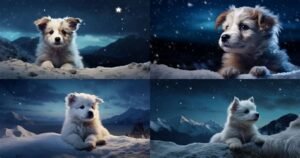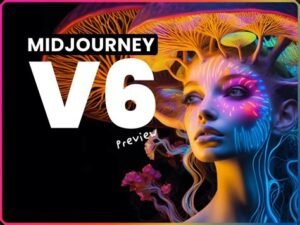Over the past few years, the world of AI-generated imagery has undergone an unprecedented transformation. What began as rough approximations of artistic intent has blossomed into a thriving ecosystem of tools capable of producing professional-quality visuals with minimal user input. Midjourney-AI has been at the forefront of this evolution, continuously raising the bar with each new release. With the arrival of Midjourney-AI Version 6 (V6), the company has delivered not just an upgrade, but a revolution. V6 takes all the foundational concepts that made its predecessors powerful and enhances them with advanced machine learning techniques, refined aesthetics, and remarkable adaptability to user intent.
V6 doesn’t just generate images—it interprets, infers, and imagines in a way that feels almost human. It can pick up on subtle cues within prompts, make aesthetic decisions that align with artistic norms, and deliver output that often rivals (or even exceeds) the work of human illustrators. This comprehensive review aims to explore every aspect of Midjourney-AI V6: A Deep Dive into the Future of AI-Powered CreativityV6 in detail—from its realism and stylistic flexibility to its interface, use cases, and implications for artists and industries alike.
1. Enhanced Realism and Detail: Bridging the Gap Between Digital and Reality
One of the most immediately striking features of Midjourney-AI V6: A Deep Dive into the Future of AI-Powered CreativityV6 is the incredible level of realism it achieves. This realism isn’t just limited to surface aesthetics—it goes deep, manifesting in the way the AI handles intricate textures, realistic shadows, facial features, and natural light dynamics. Unlike previous versions where images sometimes carried a slightly surreal or “AI-polished” look, V6 often produces results that are indistinguishable from high-resolution photographs. This leap forward has enormous implications, especially for industries like digital marketing, entertainment, product design, and even journalism.

In side-by-side comparisons with real photos, it’s not uncommon for people to mistakenly assume that a Midjourney-AI V6 image is an actual photograph—especially when dealing with portraits, food photography, or scenic landscapes. The rendering of skin tones is particularly noteworthy. V6 handles melanin variations, pores, lighting direction, and facial asymmetry with finesse, ensuring that the generated subjects appear convincingly human. This also extends to fabrics and materials: denim looks rugged and textured, silk flows with believable softness, and metallic objects reflect their environment with near-perfect lighting logic.
This level of realism was achieved through a combination of refined training data, expanded model size, and better optimization algorithms that allow the AI to render at higher resolutions without compromising accuracy. It’s safe to say that Midjourney-AI V6 has bridged the once-large gap between AI-generated art and reality—ushering in a new era of ultra-realistic digital content.
2. Improved Prompt Interpretation: Communicating with a More Intuitive AI
Perhaps one of the most important upgrades in V6 is its improved ability to understand and interpret prompts. Where earlier versions sometimes struggled with ambiguity or overly specific input, V6 is noticeably more precise and nuanced in its comprehension. Whether you provide a highly detailed paragraph of instructions or a simple phrase, V6 seems to “get” what you’re trying to convey. It can extrapolate emotion, theme, era, and mood from subtle context clues in your input.

The prompt: “A young woman in a 1920s Parisian café, sipping coffee, wearing vintage fashion, moody lighting” generates a beautifully composed, thematically cohesive image with Art Deco design elements, correct historical attire, and a palpable ambiance reminiscent of black-and-white cinema. The AI even adds background characters and architectural elements that fit the setting, unprompted. This kind of deep contextual awareness is what separates Midjourney-AI V6 from most other AI image generators currently on the market.
V6 is also better at rejecting or ignoring “bad” prompts—those with contradictory or nonsensical instructions. Instead of generating incoherent images, it attempts to prioritize the most logically consistent interpretation of the request. This makes the creative process much smoother, requiring fewer iterations and leading to faster results. Writers, designers, and creatives can focus more on storytelling and composition rather than battling the quirks of the tool.
3. Style Versatility: From Photorealism to Abstract Expressionism
While Midjourney-AI V6 excels at photorealism, it doesn’t stop there. The system is built to support an extraordinary variety of artistic styles—each one with its own unique rules, textures, and aesthetics. Whether you want a 17th-century oil painting, a colorful graffiti wall, a piece in the Japanese ukiyo-e style, or an image reminiscent of 90s anime, V6 can deliver. What’s more impressive is that it not only mimics the surface-level style but also understands the deeper rules that govern how that style works—like composition, brushstroke dynamics, and cultural color theory.

This breadth of stylistic coverage makes V6 an ideal companion for concept artists, illustrators, and even fine art connoisseurs. You can use it to prototype ideas across genres before committing to one for a final project. Some creators are using V6 to develop entire comic books, style guides, branding kits, and marketing materials—all with visual consistency across a theme or campaign. And because the AI maintains a memory of context across prompt variations, it’s easy to tweak a scene or character without completely starting over.
This isn’t just a tool for creating standalone visuals—it’s a collaborative engine that can shape entire creative worlds.
4. User Experience and Accessibility: Art for Everyone
Let’s talk about usability, because what good is a powerful tool if it’s hard to use, right? One of the most appealing things about Midjourney V6 is that it doesn’t require you to be a tech wizard or an art school graduate to create something jaw-dropping. Whether you’re a hobbyist, a social media manager, a game dev, or someone who’s never even used Photoshop before—this tool meets you where you are.
Midjourney-AI is still run through Discord, which might feel a little weird at first if you’re used to more traditional apps. But once you get the hang of it, it’s actually pretty straightforward. You type in a prompt, hit enter, and voilà—within seconds, you’ve got a set of image results to choose from. You can upscale any of them, make variations, or tweak your prompt and try again. And with V6, the results are so much closer to what you imagined on the first try, which makes the whole process a lot less frustrating and a lot more fun.
What’s really cool is that the learning curve feels gentle. You can start simple—“cyberpunk city at night”—and get a beautiful image. But as you get more comfortable, you’ll find yourself playing with composition, lighting, even camera angles and lens types. (Yeah, it understands stuff like “shot on 35mm film” or “isometric view”!) It’s like leveling up in a video game, but with art.
Accessibility is another win. You don’t need a beefy PC or expensive software—just a Discord account and an internet connection. That lowers the barrier for entry in a huge way, especially for people in places where high-end hardware is hard to come by. In short, Midjourney-AI V6 is democratizing creativity in a big, big way.
5. Artist Workflows: A Game-Changer for Creative Professionals
Now, if you’re a working artist, designer, or content creator, you might be wondering: “Okay, but how does this actually fit into my workflow?” Totally fair question. The short answer? It can slot in wherever you need it—ideation, prototyping, production, or even just creative inspiration on a slow day.
Say you’re a concept artist working on a sci-fi video game. You’ve got five factions, each with its own vibe, color palette, and worldbuilding. Normally, that’s weeks of sketching, mood boards, and exploration. With Midjourney V6, you can whip up dozens of visual concepts in an afternoon. Want to show your team a possible look for a post-apocalyptic city built on rusted-out oil rigs? Just describe it. Want to visualize a noble house from a desert planet with beetle-inspired armor and sand-blasted temples? Type it in. Boom. Done.
Even better—V6 helps you get unstuck. Hit a creative wall? Type a few mood words or phrases into the prompt bar and let the AI surprise you. Many artists have said that using Midjourney is like having a sketching partner who never sleeps and is endlessly imaginative.
It’s not replacing human creativity—it’s amplifying it. You’re still the director, the stylist, the storyteller. Midjourney just gives you a rocket-boost on the visual side, so you can iterate faster, dream bigger, and pitch with more impact.
6. Real-World Use Cases: Beyond the Art Studio
It’s tempting to think of Midjourney V6 as just a tool for artists, but its applications go way beyond that. Businesses, educators, marketers, architects—you name it—are all starting to tap into the magic.
For example:
- Marketing and Branding: Need unique visuals for a campaign? V6 can generate custom graphics that align perfectly with your brand’s aesthetic, tone, and message. No more digging through generic stock image sites.
- Publishing: Authors and editors can use it to create book covers, chapter illustrations, or even character portraits for fantasy series.
- Interior and Fashion Design: Visualize different fabric combinations, color schemes, room layouts, or even haute couture outfits in real time.
- Game Development: Build out entire worlds, character rosters, UI mockups, or even icons and item concepts before passing things to a 3D team or illustrator.
- Education: Teachers and researchers can use V6 to create visual aids, from historical reconstructions to scientific diagrams and imagined future tech.
The tool isn’t just flexible—it’s adaptable. The more niche your need, the more V6 seems to rise to the occasion.
7. Ethical Considerations: Let’s Talk About the AI Elephant in the Room
Now, we can’t have a serious discussion about AI-generated art without touching on the ethical stuff. Who owns the art? Is it okay to train models on works by real artists? What happens to creative jobs?
These are big, messy questions, and there aren’t always easy answers. But here’s where Midjourney V6 is trying to do better: they’ve increased transparency about how the model is trained, they’re giving users more control over privacy settings, and they’ve been encouraging thoughtful dialogue about AI’s place in the creative ecosystem.
For artists, the key takeaway is this: tools like Midjourney aren’t here to replace your voice—they’re here to give you more of it. You can use AI to enhance your output, test ideas faster, and reach audiences in new ways. And with features like style tuning and prompt weighting, you can still make art that’s unmistakably you.
That said, there’s still work to be done. We need better attribution systems, clearer copyright guidelines, and tools that help artists protect their style if they choose. The good news? The conversation is happening, and V6 is part of that movement toward more ethical, artist-forward AI.
8. Final Thoughts: Midjourney-AI V6 and the Future of Creativity
So, where does this leave us? Honestly, standing at the edge of a whole new era of creativity. Midjourney-AI V6 isn’t just an upgrade—it’s a shift. A turning point. It changes what’s possible for artists, businesses, educators, and storytellers alike.
The images it generates aren’t just beautiful—they’re empowering. They help people dream bigger, build faster, and share more vividly. Whether you’re making a game, starting a brand, writing a novel, or just having fun with weird prompts (“a jellyfish driving a convertible on Mars”—try it!), Midjourney-AIV6 is the kind of tool that puts a spark back in your creative process.
And honestly? That’s the kind of tech we need more of.
9. Prompt Crafting Tips: Speaking the Language of Midjourney V6
So you’ve got access to Midjourney V6, you’re typing in a few words, and you’re getting decent images… but you know there’s more under the hood. That’s where good prompt crafting comes in. Think of prompts as your conversation with the AI. The clearer and more intentional you are, the more Midjourney gives you exactly what you’re imagining—or sometimes something better.
Below are some practical tips, examples, and tricks to help you level up your prompt game. Let’s go from casual scribbler to prompt wizard.
🎯 1. Start with the Core Concept
Every good prompt starts with a main idea. This is the foundation of your scene, subject, or style. Keep it simple and focused, like:
- A futuristic city skyline at sunset
- A steampunk dragon flying over a Victorian town
- A photorealistic portrait of a samurai woman
These are solid jumping-off points. Once you’ve nailed the concept, you can start layering in the details that make your image sing.
🪄 2. Add Descriptive Flourishes
Just like seasoning a good meal, adding descriptive details brings your image to life. Think about elements like:
- Mood: dreamy, ominous, tranquil, vibrant
- Lighting: soft light, golden hour, cinematic shadows, neon glow
- Textures: rough stone, flowing silk, glossy chrome
- Colors: desaturated, monochrome, pastel tones, vivid red and gold
Here’s a before-and-after to show the difference:
Basic:
An elf warrior in a forest
Enhanced:
A cinematic portrait of an elven warrior in a misty, enchanted forest, golden hour lighting, glowing emerald eyes, intricate silver armor, atmospheric fog
See how much more vibe you get from just a few added phrases?
🔁 3. Use Style Tags and Art References
Midjourney V6 is a stylistic chameleon. You can tell it to emulate real-world artists, mediums, or genres, and it will usually nail the look. Try referencing:
- Famous artists: in the style of H.R. Giger, Picasso, Van Gogh
- Photography: shot on 35mm film, f/1.8 bokeh, cinematic lighting
- Art styles: digital painting, vaporwave, charcoal sketch, Ukiyo-e
- Mediums: watercolor, oil on canvas, graffiti, ink drawing
Example:
A lion wearing a crown, oil painting, Renaissance style, dark baroque background, Rembrandt lighting
This produces a dramatically regal image with deep shadows and classical touches.
🧠 4. Give the AI a Point of View (POV)
Want your image to feel more like a moment in a movie or a still from a dream? Add point-of-view cues like:
- From above, low angle, over-the-shoulder view
- First-person perspective, drone view, wide angle lens
Prompt example:
A cyberpunk motorcyclist racing through neon-lit streets, low angle, motion blur, shot from behind, 24mm wide lens
It feels like you’re in the scene, not just looking at it.
💡 5. Embrace Creative Prompt Structures
Some power users swear by a structure to help organize their thoughts. Here’s a popular one you can remix:
markdown
CopyEdit
[Subject], [Scene/Context], [Style/Medium], [Mood/Lighting], [Perspective/Camera], [Color Palette]
Example prompt using that format:
Ancient forest temple, overgrown with vines and moss, digital matte painting, mysterious and moody, aerial view, emerald and gold color palette
Even if you don’t use the structure every time, it’s a great reminder of all the ingredients you can play with.
🔮 6. Experiment with Parameters and Prompt Weighting
Midjourney V6 is smart, but sometimes it needs a little direction. That’s where things like prompt weighting and stylize parameters come in.
- :: can weight one part of a prompt more than another.
Example: white tiger::2, underwater ruins::1, pastel color palette - –style raw makes the image less stylized and more literal.
Try:
minimalist architectural concept –style raw - –ar 16:9 changes the aspect ratio
Wide cinematic shot? Use –ar 16:9.
Portrait? Try –ar 9:16.
Don’t worry if this feels a little nerdy at first—it quickly becomes second nature.
🧪 7. Try Prompt Remixing (Iterative Design)
This one’s underrated. Instead of starting from scratch every time, remix your own prompts like a DJ:
- Take a base prompt and swap out one detail at a time
- Use Midjourney’s “/prefer remix” feature (in Discord settings)
- Create an evolving series or storyboard by varying lighting, emotion, or style
For example:
markdown
CopyEdit
Prompt 1: “Witch in a forest, moonlight, glowing spells, eerie fog”
Prompt 2: “Witch in a desert, golden sunset, swirling dust, ancient ruins”
Prompt 3: “Witch in a futuristic city, neon glow, rain-soaked streets, cybernetic eye”
Now you’ve got a trilogy of witch aesthetics just from playing with the setting.
📸 8. Reference Real-Life Visuals
Midjourney gets better when you feed it real-world references—stuff you might find in photography, fashion, nature documentaries, or cinematic stills.
Examples:
- “Inspired by Wes Anderson films” → highly stylized, symmetrical, pastel frames
- “Editorial fashion shoot, Vogue style” → high-glam, polished model shots
- “Planet Earth documentary style” → crisp nature close-ups with dramatic lighting
When in doubt, pull inspiration from the media you already love.
Bonus Tip: Weird Prompts Are Welcome
Seriously, don’t be afraid to get weird. Some of the best art comes from play. Try:
- “A jellyfish disco rave in a lava lamp”
- “A cat detective solving a crime in 1930s Chicago, noir style”
- “A haunted ice cream truck in the middle of the desert”
V6 doesn’t just tolerate your strange brain—it thrives on it.

